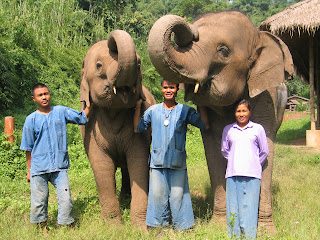Sometimes it is hard to separate fact from fiction,
especially when there are many myths and misconceptions surrounding elephants.
My next few blogs will address some of these myths and provide some facts.
The myth that elephants are afraid of mice has been
perpetrated in many cartoons and films including the famous Disney film, Dumbo.
The depiction of a large elephant cowering from a minuscule mouse is common in
these cartoons. There are many theories surrounding this myth, although the
origin is unknown, and also much speculation both for and against. This blog
will present some evidence and reach a conclusion as to whether elephants, the
largest living land mammals, are indeed afraid of small mice.
Elephants are afraid of mice:
1. TRUE:
Some people believe that elephants are afraid of mice because they nibble their
feet and will crawl inside and block their trunks. This myth dates back to an
Ancient Greek fable about a mouse that climbed inside an elephant’s trunk and
drove it crazy.
FALSE: There is no evidence to suggest any truth in the above belief.
Also, elephants could easily blow or eject a mouse from their trunk. Moreover,
it is very unlikely that a mouse would make it up the elephant’s trunk anyway.
2. TRUE:
There is a widely-circulating story in the media about an episode on
‘Mythbusters’, indicating that elephants are indeed afraid of mice. The
Mythbuster team set up an experiment to test the myth. They hid a mouse under a
ball of elephant dung and, when an elephant approached, they flipped the dung
and revealed the mouse. The approaching elephant was startled and quickly moved
away from the mouse. They then used a control condition in which there was no
mouse under the dung and the elephant did not react at all. Finally, they
repeated the first experiment to confirm their results, and the elephant
noticed the mouse and once again actively avoided it. Even though the elephant
did not panic at the sight of the mouse, the fact that it moved cautiously
around them was enough for the Mythbuster team to state that the myth could be
considered plausible. Below is a link to this clip.
http://www.youtube.com/watch?v=WpTSA_25wGE
FALSE: There are some issues in relation to the MythBuster’s
experiment which need to be considered:
·
Sample size- ‘mythbusters’ only tested one
elephant which is not a big enough sample size to claim that this myth is true
for a whole population of elephants.
·
Even though, in the experiment, the elephant
clearly responds to the presence of the mouse, it could be argued that the
elephant’s reaction is due to surprise and not fear.
·
The elephant in the clip only stops when it sees
the mouse in its path. It then steps sideways which could indicate that the
elephant is actually just avoiding stepping on the mouse.
·
There were not enough controls in the experiment
to determine whether it was actually the presence of the mouse that caused the
elephant to respond the way it did. How would the elephant have reacted if it
was a small remote controlled toy or another small animal like a rat or gerbil?
Would the elephant have responded the way it did if the mouse was black, not
white? How would the elephant have reacted if it saw the mouse approaching from
a distance and it wasn’t so much of a shock?
·
The presence of the film crew could also have
made the elephant anxious beforehand.
Other evidence suggesting the
myth is FALSE:
1. Elephants
in zoos are frequently exposed to mice because they are commonly found in and
around the elephants hay. Zoo keepers have observed that elephants pay no
attention to them, show no fear or anxiety and just ignore them.
2. There
is no scientific evidence for rodent phobia in any animal.
3. Elephants
have poor eye sight and have periphery vision. They may have difficulty seeing
anything running underneath them, so if a small animal, including a mouse, was to
run underneath an elephant, it may indeed get a fright, as it is something
unexpected, something that the elephant can’t quite see and something strange.
4. In
the wild, anything that suddenly runs or slithers past elephants’ feet will
startle them.
Thus, in
conclusion, one cannot claim that elephants are afraid of mice and so the myth
is FALSE. The evidence against the myth is clear. Elephants will be startled if
there is a moving object running under their feet. This could be dogs, cats,
snakes, mice, rats or anything that makes sudden movements.





























